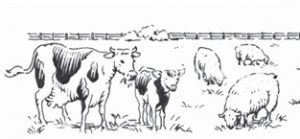24 hour emergency service
017683 51819
Office opening hours
Monday-Friday 8am - 6pm
Saturday 9am - 1pm
Sunday 10am - 11am
Crosscroft Industrial Estate Appleby-in-Westmorland CA16 6HX

NEWSLETTER
November 2018 Edition

This month we have some more exciting news as we are thrilled to welcome Ruth and Sophie
as new directors of Tethera. We are very happy to have found two vets with the qualities to develop develop the business and keep the company in private hands.
A thank you to everyone who has attended our BVD Stamp It Out meetings. If you didn't manage to get to one of our meetings this year, fear not, we will be arranging more in the new year. If you think you may be interested in attending one of our future meetings then please give us a ring or mention it when you're in so we can give you some more information.
Focus on Mastitis
Which bacteria is causing my mastitis?
Mastitis is an unwelcome presence on all farms to a greater or lesser degree, the key to managing ma
stiti
s is knowing what you’re up against. The definitive way to know is to take a sterile milk sample from a mastitic cow to have i
t cultured BEFORE you treat her. Taking a sterile milk sample is important here as we only want to culture what’s in the milk, not what’s on her udder and teat skin.
Here's a reminder on taking a sterile milk sample:
- Wear Gloves
- Strip teat X4
- Brush off excess dirt with paper towel and predip (leave on for 2030s)
- Dry and remove predip from teats
- Using spirit, clean the teat end until swab comes away clean, use a separate swab for each teat and clean the farthest teats first (if collecting from all teats)
- Open collection tub, angle at 45 degrees to the teat and hold cap upside down to prevent contamination, do not allow the teat end to touch the
- Collect 35ml of milk in the container, do not overfill, sample nearest teats first
- Clearly label samples with cow number and quarter
- Chill samples until they can be delivered to Tethera
It’s a good idea to try and take samples from all clinical cases and freeze, these can then be submitted for culture at a later date should you need.
Different causes of mastitis
Staph Aureus, a contagious bacteria (often spreading cow to cow during milking time), can cause both clinical and subclinical mastitis so you may just see high somatic cell counts (SCC). Often difficult to eradicate from the udder and can result in cows intermittently having high SCCs on record.
Control measures include hygienic milking practices, effective dry cow therapy for high cell count cows, good parlour upkeep to prevent teat damage, and consistent culling policies.
Strep Uberis, found mainly in the environment but there is also evidence for spread cow to cow, straw yards are a big risk factor for this kind of mastitis. It can cause both clinical mastitis cases and elevated SCCs.
Control, maintaining a hygienic environment and including both pre and post dipping in milking routine.
E.coli, found in the environment (high numbers in soiled bedding and faeces), wet and humid conditions will increase the rates of infections in cattle housed and at pasture. Cows are at a high risk of developing E.coli mastitis just after drying off and just prior to calving. Subclinical infections are uncommon, cows with clinical mastitis vary from mild and selfcuring cases to severe and life threatening infections.
Control, improving general hygiene and good teat hygiene at drying off and in the parlour.
Strep dysgalactiae, more widely distributed in the environment than agalactiae, cows are often infected between milkings when the teat end comes into contact with faeces or soiled bedding. Infection can also occur at milking time if there is poor udder preparation or if there is poor teat condition. Clinical cases are relatively easy to treat.
Control, good milking routine with attention paid to teat condition and maintaining cleanliness in the shed.
Strep agalactiae, this bacteria survives only in the udder, so is easier to eradicate from the herd than some other bacteria.
Commonly causes subclinical mastitis and is transmitted cow to cow. Often it only affects one quarter and bacteria are excreted intermittently causing peaks and troughs in your SCC data.
Control, good milking routine, appropriate antibiotic usage for clinical mastitis cases and for high cell count cows at drying off.
New Product
Introducing ANIMEDAZON SPRAY a new blue spray to try
Reducing Losses in Early Pregnancy in Sheep
The weeks surrounding tupping and just afterwards are crucial in deciding the scanning % and therefore the success of your lambing period. Early embryonic losses are not uncommon in sheep and can be due to a range of factors that  you can address to avoid a low scanning %.
you can address to avoid a low scanning %.
- Ensuring ewes are at the correct body condition score prior to tupping will give the best chance of Ideal body condition score is between 2.5
3.5 (depending on upland or lowland flock). It is important to maintain this condition into early pregnancy and keep your ewes on a level plane of nutrition for the first month encouraging embryos to hold. Avoid a sudden change of diet if the weather turns in early winter, supplement your ewes with some extra forage. After implantation occurs (months 2 & 3) ewes may be allowed to slowly lose 0.5 of a condition score if they were tupped at the ideal BCS. Thin ewes should be encouraged to slowly gain weight over this period.
- Infections can cause pregnancy losses, either directly (toxoplasma can cause early losses) or indirectly through making the ewe immunosuppressed or decreasing the availability of nutrients (chronic fluke or fever).
- Toxoplasma lifecycle reminder cats are the definitive host for toxoplasma and shed oocysts in their faeces, the oocysts can then contaminate pasture and infect Toxoplasma can then be spread transplacentally and cause foetal death in early pregnancy, still born and weak lambs if the infection occurs mid pregnancy or birth of normal but infected lambs if ewes are infected late pregnancy. The infected but otherwise normal lambs will abort their first lamb if kept and bred from. Vaccination is the best control measure to prevent and limit further abortions.
Enzootic abortion, caused by chlamydophila abortus and transmitted from sheep to sheep through abortion material and discharge. Ewes infected during late pregnancy (last six weeks) will abort the next pregnancy. Vaccination is the best control measure.
- Selenium/Iodine deficiency, ewes deficient in selenium can have a lowered fertility and produce lambs with white muscle disease, ewes deficient in iodine can have late abortions, still born and weak Selenium and Iodine appear to work together to ensure that brown fat is mobilised properly in young lambs which improves lamb survival. It is important therefore to ensure the diet being fed to the ewes contains sufficient amounts of both minerals.
